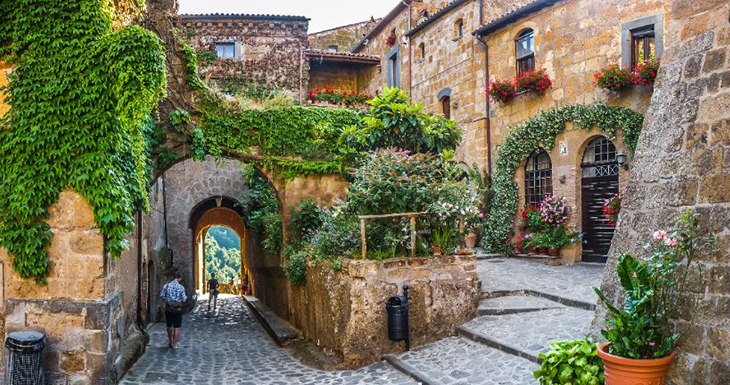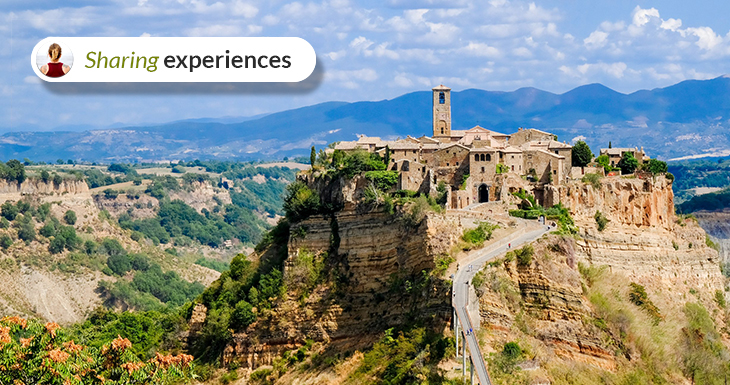Today I invite you to tour Civitá di Bagnoregio - a small Italian town located in the northern part of the Lazio Region, or Lazio in Italian, between the cities of Viterbo and Orvieto - which is on the list of the most beautiful towns in Italy .
Knowing it is an invitation to let myself be captivated by its narrow streets, its infinite landscapes, its delicious cuisine, its overwhelming tranquility and of course, by that dolce far niente that characterizes the country of pizza and pasta so much.
I will start my story by telling you that the most striking thing about this town is that it rises like an islet at 443 meters high, and is accessed by a narrow 300-meter pedestrian viaduct, where cars are prohibited. It offers a setting of unusual charm, almost surreal. Formerly, it was linked to Bagnoregio, but an earthquake separated them in the 18th century and now they are only connected by the pedestrian bridge.
Crossing said bridge and entering the historic center of Civita di Bagnoregio costs €1.5. This symbolic fee has been in operation since 2013, when the mayor of Civita di Bagnoregio established it for conservation work on the site.
The “Porta di Santa Maria” (Santa Maria Gate), or Porta della Cava, is the only possible access to the town. With a loggia of three arches - once at the top and catching my breath - I was able to admire the beauty of the door carved in tuff, a limestone that is formed by precipitation of lime dissolved in water or by accumulation of ashes or other very small volcanic elements.
Already inside the semi-uninhabited town - it has only 12 inhabitants - I understood why they call it «The city that dies». Located on top of a clay hill, it is suffering a slow but inexorable collapse due to the action of atmospheric phenomena such as wind, rain and subsoil instability. They told me that the latest geological studies have shown that in 100 years the height of Civitá di Bagnoregio has decreased by approximately 25 centimeters, and the erosion suffered by the walls causes the edges to shrink by about 7 centimeters a year. That is to say, little by little, the palaces and buildings of the small town will crumble until they disappear. What a pity!
The main attractions I visited in Civita di Bagnoregio
When I began to walk through its narrow streets surrounded by typical medieval houses with external stairs and flowery balconies, I was transported to very distant times. The Romanesque bell tower of the church of San Donato in the square of the same name stands out slender in the landscape modeled by the forces of nature.
I continued my journey until I reached the small, perfect and silent Piazza di San Donato, whose main characteristic is the absence of the central floor. In its place is a mix of red earth and gravel, giving the square a truly medieval look.
The Church of San Donato has a Renaissance facade, the result of the transformations it has undergone over time, which is flanked by the bell tower from the 12th century, with two Etruscan sarcophagi in basalt stone incorporated at the base.
For lunch I chose to walk the main street of Civita di Bagnoregio, where there are various proposals for the most demanding palates. They recommended me to try the best panini in the area, in L' Arco del Gusto where its focaccia is famous throughout the town. More than 20 options for all tastes, an ideal delicatessen to regain strength in the middle of the day. I ordered the “Del Frate” focaccia with local cheese, walnuts and honey that I accompanied with a cool drink, in a shady place: an excellent rest before continuing on my way.

My next stop was in the eastern part of the Belvedere, where the cave of San Buenaventura is located, an ancient Etruscan tomb used in the Middle Ages by hermits. The cave takes its name from San Bonaventura di Bagnoregio, considered one of the most important biographers of San Francisco de Asis. Tradition tells that in this cave little Saint Bonaventure was miraculously cured of a fatal illness through the intercession of Saint Francis. This is how the miraculous man chose to consecrate his life to God by entering the Franciscan Order taking the name of Bonaventure, in memory of the words that Saint Francis said to him after his recovery: bona ventura.
A recommendation for those who come to visit: the best photos of the town are taken from the Belvedere and at the beginning of the bridge, while the best photos of the valley are obtained from the eastern part of the citadel.
At the end of the day, I return with the feeling of having visited an incredible place, from a geographical, historical and emotional point of view. I think it's worth coming to this place, because it's charming and also because, in this way, we can contribute to its conservation. Just knowing that there is a possibility that it will disappear in a few years adds spice to the visit.


